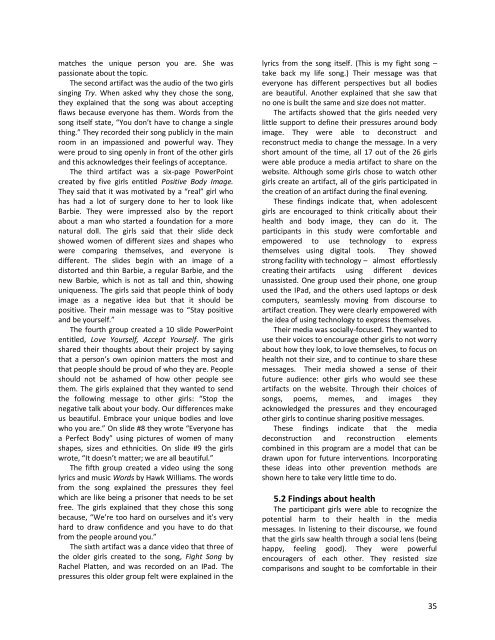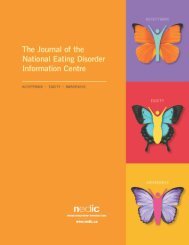NEDIC Conference Journal 2018
You also want an ePaper? Increase the reach of your titles
YUMPU automatically turns print PDFs into web optimized ePapers that Google loves.
matches the unique person you are. She was<br />
passionate about the topic.<br />
The second artifact was the audio of the two girls<br />
singing Try. When asked why they chose the song,<br />
they explained that the song was about accepting<br />
flaws because everyone has them. Words from the<br />
song itself state, “You don’t have to change a single<br />
thing.” They recorded their song publicly in the main<br />
room in an impassioned and powerful way. They<br />
were proud to sing openly in front of the other girls<br />
and this acknowledges their feelings of acceptance.<br />
The third artifact was a six-page PowerPoint<br />
created by five girls entitled Positive Body Image.<br />
They said that it was motivated by a “real” girl who<br />
has had a lot of surgery done to her to look like<br />
Barbie. They were impressed also by the report<br />
about a man who started a foundation for a more<br />
natural doll. The girls said that their slide deck<br />
showed women of different sizes and shapes who<br />
were comparing themselves, and everyone is<br />
different. The slides begin with an image of a<br />
distorted and thin Barbie, a regular Barbie, and the<br />
new Barbie, which is not as tall and thin, showing<br />
uniqueness. The girls said that people think of body<br />
image as a negative idea but that it should be<br />
positive. Their main message was to “Stay positive<br />
and be yourself.”<br />
The fourth group created a 10 slide PowerPoint<br />
entitled, Love Yourself, Accept Yourself. The girls<br />
shared their thoughts about their project by saying<br />
that a person’s own opinion matters the most and<br />
that people should be proud of who they are. People<br />
should not be ashamed of how other people see<br />
them. The girls explained that they wanted to send<br />
the following message to other girls: “Stop the<br />
negative talk about your body. Our differences make<br />
us beautiful. Embrace your unique bodies and love<br />
who you are.” On slide #8 they wrote “Everyone has<br />
a Perfect Body” using pictures of women of many<br />
shapes, sizes and ethnicities. On slide #9 the girls<br />
wrote, “It doesn’t matter; we are all beautiful.”<br />
The fifth group created a video using the song<br />
lyrics and music Words by Hawk Williams. The words<br />
from the song explained the pressures they feel<br />
which are like being a prisoner that needs to be set<br />
free. The girls explained that they chose this song<br />
because, “We’re too hard on ourselves and it's very<br />
hard to draw confidence and you have to do that<br />
from the people around you.”<br />
The sixth artifact was a dance video that three of<br />
the older girls created to the song, Fight Song by<br />
Rachel Platten, and was recorded on an IPad. The<br />
pressures this older group felt were explained in the<br />
lyrics from the song itself. (This is my fight song –<br />
take back my life song.) Their message was that<br />
everyone has different perspectives but all bodies<br />
are beautiful. Another explained that she saw that<br />
no one is built the same and size does not matter.<br />
The artifacts showed that the girls needed very<br />
little support to define their pressures around body<br />
image. They were able to deconstruct and<br />
reconstruct media to change the message. In a very<br />
short amount of the time, all 17 out of the 26 girls<br />
were able produce a media artifact to share on the<br />
website. Although some girls chose to watch other<br />
girls create an artifact, all of the girls participated in<br />
the creation of an artifact during the final evening.<br />
These findings indicate that, when adolescent<br />
girls are encouraged to think critically about their<br />
health and body image, they can do it. The<br />
participants in this study were comfortable and<br />
empowered to use technology to express<br />
themselves using digital tools. They showed<br />
strong facility with technology – almost effortlessly<br />
creating their artifacts using different devices<br />
unassisted. One group used their phone, one group<br />
used the IPad, and the others used laptops or desk<br />
computers, seamlessly moving from discourse to<br />
artifact creation. They were clearly empowered with<br />
the idea of using technology to express themselves.<br />
Their media was socially-focused. They wanted to<br />
use their voices to encourage other girls to not worry<br />
about how they look, to love themselves, to focus on<br />
health not their size, and to continue to share these<br />
messages. Their media showed a sense of their<br />
future audience: other girls who would see these<br />
artifacts on the website. Through their choices of<br />
songs, poems, memes, and images they<br />
acknowledged the pressures and they encouraged<br />
other girls to continue sharing positive messages.<br />
These findings indicate that the media<br />
deconstruction and reconstruction elements<br />
combined in this program are a model that can be<br />
drawn upon for future interventions. Incorporating<br />
these ideas into other prevention methods are<br />
shown here to take very little time to do.<br />
5.2 Findings about health<br />
The participant girls were able to recognize the<br />
potential harm to their health in the media<br />
messages. In listening to their discourse, we found<br />
that the girls saw health through a social lens (being<br />
happy, feeling good). They were powerful<br />
encouragers of each other. They resisted size<br />
comparisons and sought to be comfortable in their<br />
35




